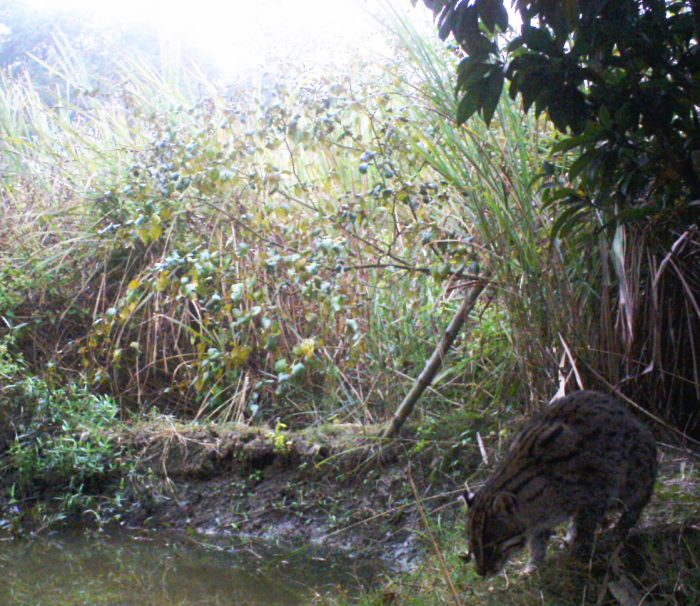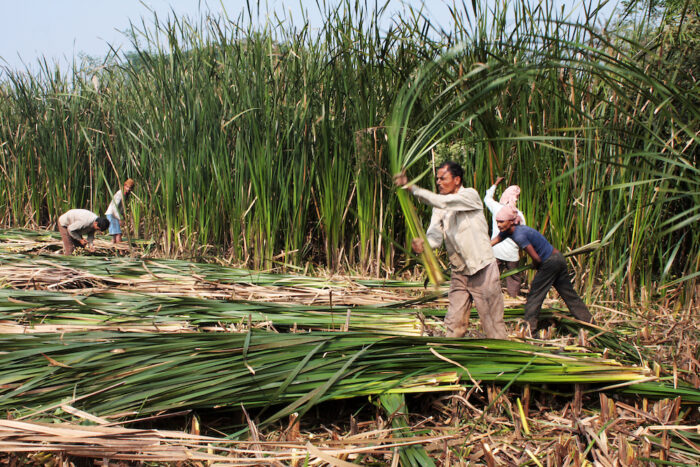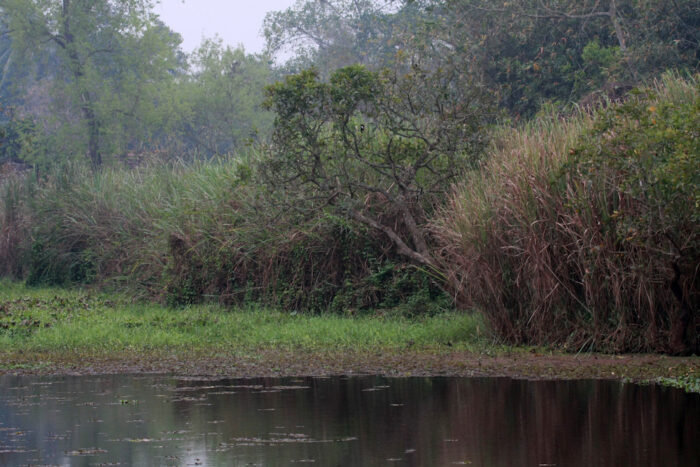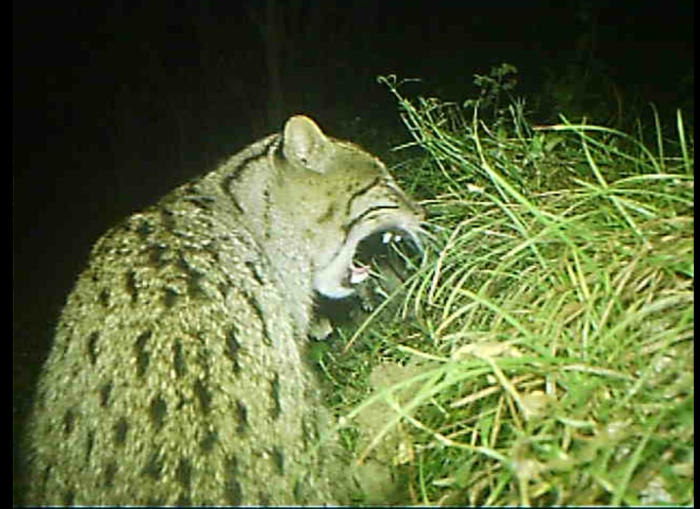Night 8 o’clock, sitting inside reed beds is not a comfortable proposition. It is a hot summer night but the men wait patiently. There is a pond just ahead and there is dearth of oxygen in it. The fish are surfacing quite frequently, gasping. All of a sudden, there is a faint rustle in the reeds, on the other side of the pond, the men are alert, they sit still waiting for the right moment to strike.
All too soon, a familiar contour emerges out of the reeds – a smaller tiger, the size of a dog. It moves around the ponds – searching, judging. Finally, an opportune perch and a dive into the water. A 2 kilo ‘Katla’ comes out hooked to its claws, in between the canine gape.

It’s time for the men to strike. With sticks-in-the-air, a screaming mob bewilders the cat out-of-its-wit. Caught off-guard, it drops the heavy catch and retreats into the reed refuge. The ‘Katla’ is picked up by the roaring men. The arch rival has been beaten at it’s own game. The trophy, is a delicious feast.
Not all in the village though are familiar with the ways of this distinguished neighbour, the state animal of West Bengal – the Fishing Cat. Some describe it’s habit to be different from a Jungle Cat’s. The latter would run when encountered. The former would probably hold its ground. However, most villagers do not venture out at night. To them, a Fishing Cat, a Jackal, a Palm and Small Indian Civets are synonymous to the night. They would, once in a while hear of the ‘gobagha’ lifting goats once in a while and that would be it.
The reed cutters who are employed once a year to cut the reed crops or ‘Khori’ chance upon the Fishing Cat quite a few times during that period. They give a perfect description of it’s call and have even reported seeing its nests, atop flattened reeds. In fact, T. Bhattacharya and others, in the 1980s, drew the structure of such a nest in their report from the same area. The story of a nest building cat is common in the coastal marshes of Thailand too, as told by Namfon Cutter, who has pioneered Fishing Cat research and conservation.

Coming back to Howrah, only certain pockets serve as the cat’s haunts. Habitat-wise, these would be comparatively low-lying areas which are inundated during the monsoon. Remnant marshes with tall, grass-like reeds are the dominant plant forms in such areas which are also cultivated as crop by local people.
To be able to live in an inundation prone area, requires people to build houses on raised grounds. Soil would be dug from surrounding areas and structures would be built on top of heaped and flattened earth making it relatively safe from seasonal floods. But this also meant that the pits formed in the surrounding areas would fill up with water and fish. Hence, small scale fish culture became the norm in such areas. A home of reeds and fish as food served as the perfect habitat for the Fishing cat.

Seven years ago, some researchers visited the region to look for signs of the cat. Their method managed to pique the interest and disgust of many, simultaneously, as the search involved looking for cat scat.To this, many old reed cultivators shared knowledge that they generally kept to themselves – that the cat came back to shit in the same place over and over again. Thorough research confirmed what the people of the region already knew – there were Fishing Cats in the area.
In the meantime, there was an increase in the awareness programs on the Fishing Cat – owing to the Zilla Parishad, the Panchayat Samiti, the Block Development Office, Gram Panchayat, local organisations and clubs. Conservation of the state animal, the Fishing Cat, became a point of discussion in various forums.

The next question from the locals was “what’s in it for us?” discussions followed. Nothing much, just an ethical stand to help life survive. A question of pride too – of living alongside the State Animal and participating in conserving it – reasoned the conservationists. “But it causes harm to my goats” said one. “It loves fish but how can you go on incurring losses, questions another. Should there be compensation?”
Compensation is tricky and can affect the dynamics of co-inhabitation. While some people walked away unconvinced and uninterested from the discussion unless there were benefits, a few others stayed back and the next question was, “Calcutta is famous because it has the Howrah Bridge. Will our villages get recognition because the state animal is found here?”
Only Time will tell.
But for now, how many Fishing Cats are present around them? Do they want to know?
A few who became friends with the researchers kept an eye out for reports on where the Fishing Cats are sighted in the vicinity. So when the researchers came back searching for places – this time to put up camera traps, their friends amongst the local community were more than happy to help.
After a few days the traps were removed. And the team squealed with happiness at the images staring back. Local crowds gathered, their curiosity piqued; sometimes with lots of children in tow. Many came forward enthusiastically suggesting other places. And the team expanded, albeit slowly.
Thereafter, the community became better, almost experts, at putting up camera traps. Regularly monitoring whether the ‘lazy cat’ which sits beside their ponds for hours came visiting or not. One was a total beauty! The videos caught it many-a-times coming to a pond on a single night. Sometimes it sat upright on the bank, staring into the water, as if time stood still. But the night did not favour it gastronomically. As it yawned, the canines gleamed in the dark as it retreated up the bank, the best trap video I have ever seen of the Fishing Cat.

A cat known for its adept fishing skills, the Fishing cat, is said to be broadly but discontinuously distributed in Asia, and is primarily found in the Terai region of the Himalayan foothills in India and Nepal, in eastern India, Bangladesh and Sri Lanka.
An occupant of wetland habitats, the cat feeds mostly on fish, frogs, crustaceans and smaller animals. Declared as Vulnerable by the IUCN in 2016, the cat population is said to have declined owing to destruction of wetlands, which are increasingly being polluted and converted for agricultural use and human settlements. While killing for skin is another worrying threat, a major threat for the fishing cat is conflict with the local people due to sharing of resources like fish.
Thank you so much. I Shall convey this to the team. Happy Fishing Cat February!
Hello Tiasa,
Your fishing cat story is brilliant and enjoyed reading it. Good to hear about local communities getting involved.